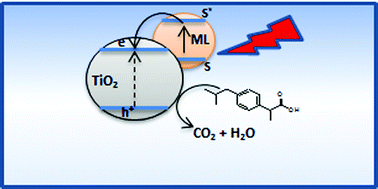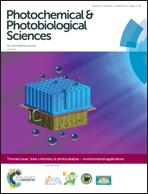Photocatalytic degradation of ibuprofen using TiO2 sensitized by Ru(ii) polyaza complexes†
Abstract
In this work, modification of TiO2 was carried out by incorporation of two novel Ru(II) polyaza complexes. The N1-(2-aminobenzyliden)-N2,N2-bis(2-(2-aminobenzyliden)aminoethyl)ethane-1,2-diaminoruthenium(II) and N1,N2-bis(2-aminobenziliden)ethane-1,2-diaminoruthenium(II) complexes were synthesized via metal–ligand direct reaction. The complexes were characterized by UV-Vis, FTIR and fluorescence spectroscopy, and the chemical composition was obtained from elemental analysis by the combustion method; additionally, the sensitized TiO2 catalysts were also characterized by XRD, SEM and diffuse reflectance techniques. The photocatalytic activity of the prepared catalysts was tested in a batch reactor under visible radiation for the degradation of ibuprofen in aqueous solution. The evolution of the drug degradation process was evaluated by high-performance liquid chromatography (HPLC), while the mineralization percentage was monitored by the determination of total organic carbon (TOC). The results indicated that the incorporation of these complexes improves the activation of TiO2 under visible light, increasing the degradation and mineralization percentage of ibuprofen up to 35% compared to the unmodified material, thereby making it suitable for application in heterogeneous photocatalysis of the said pharmaceutical in aqueous media using visible light as the energy source.

- This article is part of the themed collection: Solar chemistry & photocatalysis – environmental applications

 Please wait while we load your content...
Please wait while we load your content...